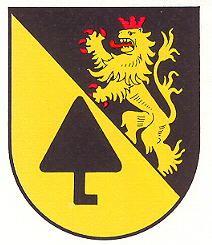Lohnweiler: Difference between revisions
Jump to navigation
Jump to search
Knorrepoes (talk | contribs) m (Text replace - "|width="15%"|50 px|right |}" to "|width="15%"|50 px|right |}<seo title="Wappen, Gemeindewappen" />") |
Knorrepoes (talk | contribs) m (Text replace - "[[Literature" to "{{media}} [[Literature") |
||
| Line 17: | Line 17: | ||
The upper half shows the lion of the Pfalz, as the village historically was ruled by the Dukes of the Pfalz. The lower half shows the old village symbol, which can be seen on the old borderstones, dating from 1750, near the village. The tool is described as a canting Lohnen, which is either a tool, or a part of a wagon-wheel. | The upper half shows the lion of the Pfalz, as the village historically was ruled by the Dukes of the Pfalz. The lower half shows the old village symbol, which can be seen on the old borderstones, dating from 1750, near the village. The tool is described as a canting Lohnen, which is either a tool, or a part of a wagon-wheel. | ||
{{media}} | |||
[[Literature]] : Debus, 1988 | [[Literature]] : Debus, 1988 | ||
Revision as of 00:57, 9 July 2014
| Heraldry of the World Civic heraldry of Germany - Deutsche Wappen (Gemeindewappen/Kreiswappen) |
LOHNWEILER
State : Rheinland-Pfalz
District (Kreis) : Kusel
Verbandsgemeinde : Lauterecken
Origin/meaning
The arms were granted on August 7, 1980.
The upper half shows the lion of the Pfalz, as the village historically was ruled by the Dukes of the Pfalz. The lower half shows the old village symbol, which can be seen on the old borderstones, dating from 1750, near the village. The tool is described as a canting Lohnen, which is either a tool, or a part of a wagon-wheel.
Contact and Support
Partners:
Your logo here ?
Contact us
© since 1995, Heraldry of the World, Ralf Hartemink 
Index of the site
Literature : Debus, 1988











